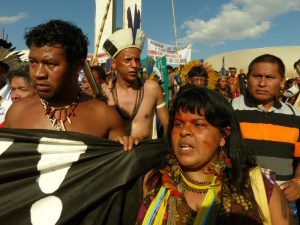Though the spread of Zika has decreased significantly since its initial outbreak in 2015, many Brazilians are still struggling with supporting children born with disabilities due to the illness, especially in favelas. In Recife, Maria De Fátima dos Santos cares for her one and a half year old daughter Eduarda Vitória. Though efforts by the Brazilian government greatly curbed the spread of Zika, some mosquitoes still survived, one biting Maria during her pregnancy. Eduarda was born with various disabilities, including microcephaly, digestion issues, reoccurring seizures, and impaired vision. Her medication is stored in a plastic bag within a bottle, tied to a pole. This prevents rats from stealing it.
Both Maria and her husband Paulo Rogério Cavalcanti de Araújo are unemployed, and receive 880 reais (about $225) monthly from the government. Welfare programs in Brazil lack support to Brazilian families in favelas, as formula was no longer sent to the family once Eduarda turned a year old. Clinics took months to schedule an appointment to get Eduarda glasses, but then failed to provide her with braces that fit her arms and legs. Physical therapy for the child is hard to get, as it is a two-and-a-half-hour walk, or thirty minutes by paying the bus fare. Maria still struggles to get the support needed to take care of her child, but is hopeful for the future.
Coverage of this event by The New York Times, though in a through attempt to be objective, still somewhat sensationalizes the problems faced by those in favelas. Emotional terms such as “cope” and “struggle” are used throughout the article, and a section on Maria’s past focuses on her time as a drug addict and prostitute. Though it’s all factual, it feels as though the issues she faces are somewhat glorified for an American audience. Though this may be an attempt to draw international attention to the issues faced by millions living in Brazilian favelas.
In combination with Waste Land / Lixo Extraordinário and Ben Penglase’s Living with Insecurity in a Brazilian Favela, this article provides a current example of the poverty many Brazilians face. Penglase’s work provides a more indepth look at what goes on beyond Maria’s household. Both discuss the issues of drug trafficking and inequality impacting those living in favelas, but Penglase furthers this discussion by examining the friendships and support systems formed around communities with shared struggles. Waste Land continues this exposure of communities in favelas and the hope for a better future by interviewing workers at Jardim Gramacho. These interactions between those in Brazil’s discarded communities add to our own analysis of how Brazilians form their own identities in their communities, race and class inequality, and the socioeconomic structure of Brazil’s welfare systems.
Source + 360 video of Maria’s home:
www.nytimes.com/2017/03/11/health/zika-virus-favela-360-video.html

